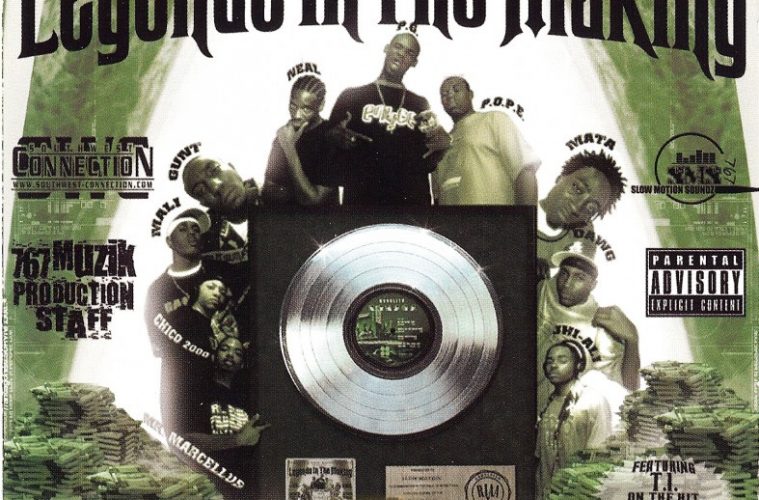In many ways, rap music has become a study in excess. Excessive guest appearances, excessive skits, and subject matters bordering on the delusional have all become commonplace. Double albums seem to epitomize this gluttony, as artists have begun to assume that we’re looking for a tub of rap instead of a shiny glass bowl. Many great albums have fumbled classic status through their sheer volume, leaving us to wade through it all instead of slimming it down themselves.
Trmndus and Slow Motion Soundz appear to present me with a solution, or at least a situation in which the double album curse shouldn’t apply. “Legends in the Making” is forty one tracks long, which is just absurd. Luckily, it’s not just one rapper trying to stay consistent over the course of such length, but several. In fact, ten artists appear on the cover, and the liner notes reveal even more names to sort out. So the personnel match the tracklisting, which is a serious blessing, because no one on here could come close to carrying an album of this size.
Of course, with the elements I’ve just mentioned, it’s pretty unreasonable to expect a cohesive record either. Even with the 767 Muzik Production Staff holding the production down, enough emcees cycle through here to disallow any sort of lyrical fluency. This doesn’t hurt too much, though. Almost everyone in this crew is engaging and unassuming, so I didn’t find myself wishing that certain rappers had gotten more shine.
These guys rap about the expected subjects, but instead of repeating themselves they create thoroughly detailed verses. While certainly not fresh in subject matter, they aren’t boring the hell out of me. And in this age, I can’t take this formality for granted. Early burners on the first disc include “Money on the Wood” by Mali Boi, DAWG, and P.O.P.E. This song is made by the hook, a slowly swerving vocal sample, and three impressive verses from the contributors.
The “Lacs and Prices” remix has J Sib, Mr. Marcellus, Pope, and a high-profile guest shot from T.I. The “featuring the hit” sticker on the front of the album led me straight to this song, and it doesn’t disappoint. I won’t spend time struggling to find words to describe this track, so let’s just say it sounds real good. T.I.’s presence seals it, as his arrogant crowing easily balances many of the higher-pitched voices on the album. “Blast OPH” is a great solo cut from South Paw, but the pounding beat from the 767 Staff is the real winner.
The second disc starts on a mellower note with “Ghetto Tearz,” the obligatory introspective track that rappers usually include to avoid accountability for the thematic matter on the rest of the album. Jhi Ali follows this with another slow cut, “My Way.” This is the best solo song on the album, because he explains his lifestyle without hiding anything. He even sings on the hook, coming across nicely there as well. On the second album, many less songs stand out as phenomenal, and this is unacceptable on a twenty-one track disc. The album’s musical overkill directly leads to many of its flaws. The 767 guys seem competent, having created a few really sick beats, but too many of their techniques become repetitious and unexciting after a while. There are ominous piano chords, overused orchestral loops, and a host of other beeps, blips, bells, and other noises that add depth to individual tracks but hurt the overall effect.
The rappers struggle similarly. Every voice on this record belongs, because they are all capable and hungry. Still, this is a case of everyone arriving at the studio with the same type of rhyme concerning either sex, drugs, material wealth, or a combination of elements. I don’t have much interest in hearing about a bunch of random guys’ impersonal stories, and because no one stands out, they all demonstrate similar degrees of skill in addition to the tired themes. The length of the album reveals this more than anything.
Taking this for what it is, I find it hard to complain. You certainly will get your money’s worth, so that’s no concern. Forty one tracks will entice plenty of people into copping, but as a critic, I find it trying to wade through the entire thing in search of the ones I need to pay attention to. If I like ten songs very much, and I have to cue them up on separate discs to listen to them, I’m much less likely to do so than if they were on one disc with fifteen tracks. Or even twenty. This music is pretty good at times, and rarely downright bad. Try spending 160 minutes listening to it straight through, though, and you’ll understand.

